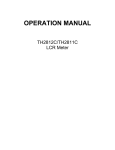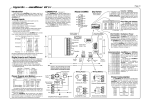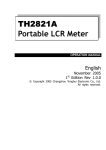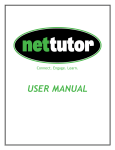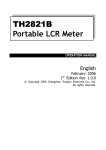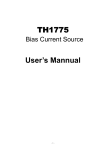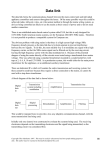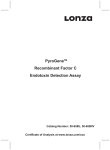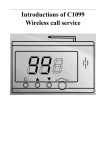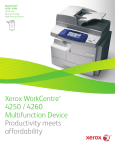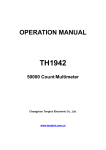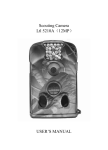Download TH2773A - Globalmediapro Ltd.
Transcript
OPERATION MANUAL TH2773A Inductance Meter Content Chapter 1 General Introduction.........................................................................................................3 1.1 Product Introduction..............................................................................................................3 1.2 Specifications ........................................................................................................................3 1.3 Main functions ......................................................................................................................4 1.4 Structure & Installation .........................................................................................................4 Chapter 2 Operation Instruction........................................................................................................7 2.1 Notice..........................................................................................................................................7 2.2 Operation.....................................................................................................................................7 2.2.1 Power ...............................................................................................................................7 2.2.2 Connecting the DUT ........................................................................................................7 2.2.3 Display .............................................................................................................................7 2.2.4 Sorting function................................................................................................................8 2.2.5 Short correction function..................................................................................................9 2.2.6 Error ...............................................................................................................................10 Chapter 3 Maintenance & Repair....................................................................................................11 3.1 Maintenance ..............................................................................................................................11 3.1.1. Notice ............................................................................................................................ 11 3.1.2 Performance checking.................................................................................................... 11 3.1.3 Troubleshooting ............................................................................................................. 11 3.1.4 Signal checking ..............................................................................................................12 3.1.5 Standard .........................................................................................................................12 Chapter 4 Product package & Warranty..........................................................................................13 4.1 Product package ........................................................................................................................13 4.2 Warranty....................................................................................................................................13 2 Chapter 1 General Introduction 1.1 Product Introduction Applying the most advanced measurement principle, TH2773A is a simple and intelligent inductance meter with predominant function design, economic price, and fast measurement speed (8 times/sec). It can measure inductance of different ranges under different frequencies. It is a good choice for inductor incoming inspection and fast sorting on product line.The instrument’s outstanding function is its sorting function, which has simply-operated parameter setting, direct result indication, and beeper function, which can easily tell the result. 1.2 Specifications 1.2.1 Measurement parameter L: inductance Q: quality factor 1.2.2 Test frequency: 1kHz±0.02% 100Hz±0.02% 1.2.3 Basic measurement accuracy: L: ±[1uH+0.3%(1+0.2mH/L+L/20H)](1+1/Q) Q: ±0.2% 1.2.4 Measurement range: L: 0.1uH~100H Q: 0.1~999.9 1.2.5 Test level: 0.3Vrms (no load) 1.2.6 Measurement speed: approx. 8times/sec 1.2.7 Pre-set range (BCD switch): Nominal inductance: 0.01uH~990H Inductance error limit: -99.9~99.9% Quality factor limit: 0~99.9 1.2.8 Temperature: 0°C~40°C Humidity: ≤80%RH 1.2.9 Power voltage: 220V±10% Frequency: 50Hz±5% Power consumption: ≤30W Dimensions and weight Dimensions: 270×130×300 Weight: approx. 5Kg 3 1.3 Main functions 1.3.1 Display mode: two display windows. Inductance (L) (or percentage deviation ∆%) , and quality factor (Q) are synchronously displayed. 1.3.2 Frequency: 100 Hz (conversion switch on), 1 kHz (conversion switch off) 1.3.3 Correction: Perform short correction by operating this key. 1.3.4 Sorting function: When Q and ∆% meet limit requirement, PASS indicator is on, and beeper alarms (can be turned on or off); When Q is not qualified, QNG indicator is on; When ∆% ≥ high limit, OVER indicator is on; When ∆% ≤ low limit, DOWN indicator is on. 1.3.5 The instrument has strong protective design against concussion. 1.4 Structure & Installation Front panel description No. Name Description Function 1 Power 2 Trademark & Model 3 Display 4 1/2-digit display L & △% are displayed 4 Display 4-digit display Value of Q is displayed 5 Manufacturer 6 Key switch to select correction display L-Q or △%-Q; to select frequency L: inductance value; △%: percentage deviation When L and △% are off, BCD switch reading is measured. CLR: short correction f: on: 100Hz off: 1KHz 7 BCD switch 8, 4, 2, 1 BCD code respectively corresponding to inductance limit, quality factor limit, high limit and low limit of inductance 8 LED indicator 9 Test terminal HD, HS, LD, LS signal test terminals HD: high driving HS: high sampling LD: low driving LS: low sampling 10 Grounding terminal connecting ground line terminal connecting the ground line of the device under test Press to ON, to turn on power PASS, OVER, DOWN, QNG respectively on according to the sorting result 4 1 R 2 TONGHUI ELECTRONICS INDICATION 3 x□ x □ x Q: □ QNG T H 27 7 3 A Inductance Meter L SORTING DOWN x□ x □ x% LO:- □ LIMITS SETUP 7 mH H ∆% Q STANDARD VALUE ※(0.XX*10 n)µΗ x □ x □ n Lm: □ 9 HD 5 4 △% HS L ! LS CLR UNKNOWN 8 PASS f 1kHz 100Hz LD 7 5 POWER ON OVER x□ x □ x% HI: □ OFF 6 Figure 1-1 Front panel overview 1 Beeper 2 220V 50Hz S/N: 98008 Changzhou Tonghui Electronic Co., Ltd. 3 4 Figure 1-2 Rear panel overview Rear panel description No. Name 1 Beeper 2 Power outlet 3 Fuse 4 Nameplate Description 2-bit switch Function ON: When the inductor is qualified, PASS indicator is on, beeper alarms (it doesn’t in other states). OFF: Beeper is turned off. fuse of 1A 6 Chapter 2 Operation Instruction 2.1 Notice 2.1.1 After unpacking, check with product package list. 2.1.2 Before operating the instrument, please read the manual thoroughly, or operate the instrument under professional personnel’s instruction. 2.1.3 Line and neutral line through which power inputs should be of the same model as those on the instrument’s power plug. 2.1.4 Connect test fixtures or test cable with four test terminals (HD, HS, LS, LD) on front panel. When test cable is used, HD & HS, LD & LS should have short connection. For the device under test (DUT) with guard shield, shielding plate should be connected with grounding terminal of the instrument. 2.1.5 The instrument should be operated in the prescriptive environment. The instrument, especially test leads connecting with the DUT, should be kept away from strong magnetic field, to avoid interference. 2.1.6 When the measurement completes or it’s necessary to open the cover of the instrument, power switch should be pressed to OFF, and please disconnect the instrument from the power source. 2.2 Operation 2.2.1 Power Perform the following steps to turn on the instrument: 1. Connect the instrument with the power source; 2. Press power switch to ON; 3. Numbers display in windows. Otherwise, restart the instrument; 4. Warm up for 15 minutes to the state of heat balance. 2.2.2 Connecting the DUT Connect the DUT, and choose suitable test fixtures or cable. When cable is used, HD & HS, LD & LS should have short connection. And the DUT’s lead should be clean to keep good connection with test terminals. 2.2.3 Display 2.2.3.1 Press key switch to select display mode to L (inductance) or △% (percentage deviation). L: The instrument doesn’t directly display obtained measurement value in window after the DUT is inserted, but judge whether the best range is selected. Only when the best range is selected, are the data sent to be displayed. The inductance is displayed in 4.5-digit, and 7 quality factor (Q) in 4-digit. △%: The instrument selects range according to the set value on BCD, and the result is output after each measurement. The measurement speed is fast up to 8 times/sec. So the mode is applied to fast measure batches of devices. The output result is displayed in 3-digit percentage, and quality factor in 4-digit. And ∆%=[(Lx-L)/L]×100%, where L is nominal value, and Lx is measurement value. In △% mode, nominal inductance is set in the mode of L×10n uH. For example, when the nominal inductance is 47 mH, 47mH=47×103 uH=0.47×105 uH, The set value should be transformed into two-digit decimal and one-digit power, as the following figure shows: 2.2.3.2 If L and △% are synchronously off, the instrument is in the state of measuring BCD switch reading. The set inductance nominal value (L), high limit value (L-), low limit value (L-), and quality factor limit value (Q-) are displayed, then press L or △% mode key. The instrument will automatically enter the measurement state after this measurement completes. 2.2.4 Sorting function 2.2.4.1 At the time of producing inductor or incoming inspection, a large number of inductors of the same model need measuring. And it needs to be known whether the component’s parameter is in some particular range, instead of its detailed value. This is sorting. What the instrument is asked to do is to get the result fast and simply. TH2773A provides the functions of one-bin inductance sorting and quality factor qualification sorting. In all the modes of inductance direct reading (L), percentage deviation (△%), and quality factor (Q), sorting function is valid. 2.2.4.2 Percentage limit and quality factor limit setting When setting bin limit, inductance qualified bin that data on BCD switch denote is in the form of percentage, and the default high limit is positive, low limit negative. For example, the inductance bin limit is set from -12.3% to 45.6%, shown as the following figure: And quality factor limit is set to 10.2, shown as the following figure: 8 quality factor The sorting procedure is shown in figure 2-1: QNG NO indicator on Qx≥Q— YES QNG indicator off NO ∆%≤L — OVER indicator on YES NO ∆%≥L— DOWN indicator on YES NO Qx≥Q— YES PASS indicator on RET Figure 2-1 Sorting procedure After setting inductance and quality factor limit, insert the inductance, to observe the indicators on panel to judge whether the inductance is qualified or not. If beeper on rear panel is turned on, beeper alarms when PASS signal is output. 2.2.5 Short correction function TH2773 has short correction function. Perform the following steps: 1. Set the instrument’s test terminals to the short state; 2. Press correction key (CLR), and short distributing parameter Lo is measured out; 3. After connecting with the DUT Lx, the actual inductance value can be calculated according to the formula: Lx=Lx’ (measurement result)-Lo (distributing parameter). 9 2.2.6 Error The instrument’s operating environment and power supply are listed in Chapter 1.2. Because range of L’s basic accuracy 0.3% and Q’s basic accuracy 0.2% is limited, please precisely evaluate the instrument’s error when measuring inductor of some inductance according to Chapter 1.2.3. In different frequencies, ranges that meet basic accuracy are as follows (Q is considered infinite in ideal state): 1KHz: 100 uH ~ 1 H 100Hz: 1 mH ~ 10 H Error factor (1+1/Qx) is omitted, and value of Q is little, so effect of Q should be considered. If according to the formula, L’s accuracy is calculated to be 0.8%, and Q is 100, actual accuracy should be 0.808%. Figure 2-2 Curve of the error 10 Chapter 3 Maintenance & Repair 3.1 Maintenance 3.1.1. Notice 3.1.1.1 The instrument should be maintained by experienced professional personnel. 3.1.1.2 At the time of maintenance, nominal frequency, resistance components, and adjustable potentiometer can’t be adjusted or changed. 3.1.1.3 If the instrument is damaged because of user’s blindfold maintenance or changing parts, the user should afford the maintenance charge. 3.1.2 Performance checking 3.1.2.1 Press display conversion key, to correctly change functions. 3.1.2.2 The instrument has checked all the working circuits, and it’s not necessary to re-debug, because frequency and resistance standards are stabile. The following components are optional to generally check the instrument’s operation. 3.1.2.3 Data’s validity It’s one of the commonly-used methods to check the instrument’s operation according to displayed data’s flicking. And the following notices should be paid attention to: a. Observe after warming up for 15 minutes; b. The chosen inductor should be stable, and standard inductor is the best choice; c. The last number is allowed to flick in the range of accuracy’s 1/3 (The inductor under test should be stable). 3.1.3 Troubleshooting 3.1.3.1 Safety precaution a. Power should be cut off when opening the cover of the instrument. b. Before maintenance, the instrument’s working principle, framework figure, circuit principle figure, and installation figure should be known well. c. Digital signal level should be less than 0.5V or more than 3V, or quickly convert impulse signal between the two states. d. If some digital signal is not normal, current level of about +2V is usually produced on signal line. e. If any trouble happens to microcomputer part, please send to local service office or our company soon. 3.1.3.2 Common trouble a. If the instrument doesn’t work, it can be tried to turn on and off power several times. If the instrument still can’t recover, R101 or C101 on A1 control PCB, or power of +5V, is 11 usually checked. b. Inductance’s high voltage may damage V205-V208, which may cause mistake of instrument’s reading, or data’s quick flicking. This is usually because R213 (3Ω 1W) is open or resistance increases. c. If the inductance’s reading is normal, but quality factor obviously increases, there are probably two reasons: 1. The test terminals don’t connect well or the test fixtures aren’t clean; 2. Performance of N207 (CD4052) gets poor. d. If measurement in one range goes well, but reading mistake happens in another range, there must be some problems with N206 (BU4053). e. Mistake happens in display panel: 1. If there is no display at all, please check link’s connection; 2. If there is no display at one segment, please change LED. 3.1.4 Signal checking If there’s still problem that can’t be solved according to 3.1.3.2, further check and analysis are needed. 3.1.4.1 Power Please first check power according to the following table: Pin No. Standard Voltage Function X105-1 +5V +5V±0.3V to supply digital circuit X105-3 DGND 0V digital ground X204-1 +5V +5V±0.3V to supply analog circuit X205-1 AGND 0V Analog ground X205-2 -8V -8V±0.4V to supply analog circuit X205-3 +8V +8V±0.4V to supply analog circuit Table 3-1 Power tip of PCB 3.1.5 Standard Analog signal’s nominating, happening and A/D conversion & comparison have close relationship with instrument’s standard. And TH2773A’s +5V standard consists of regulator V223, dynatron V224, and peripheral circuit. Observed through oscilloscope, pin e of V224 should be direct current signal of +5V, or measured through digital multimeter, it should be direct current signal of precise +5V. Note Analog signal ground (AGND) and digital signal ground (DGND) are absolutely separate. At the time of maintenance, don’t connect them, otherwise, unexpected mistake will happen. 12 Chapter 4 Product package & Warranty 4.1 Product package The product package should include the following item: 1. TH2773A inductance meter 1 2. TH26004-1 4 terminal Kelvin test leads 1 3. three-core power cord 1 4. fuse 2 5. operation manual 1 6. product qualified certificate 1 7. warranty card 1 8. package list 1 9. testing report 1 After receiving the instrument, user should unpack to check. If there’s any problem, please contact Tonghui Electronic Co., Ltd. or sales office at once. 4.2 Warranty This instrument has 18 months’ free warrant, and lifetime’s maintenance. Please show warranty card at the time of maintenance. During the period of free warrant, if the instrument is damaged because of use’s misuse or wrong operation, user should afford the maintenance charge. 13













